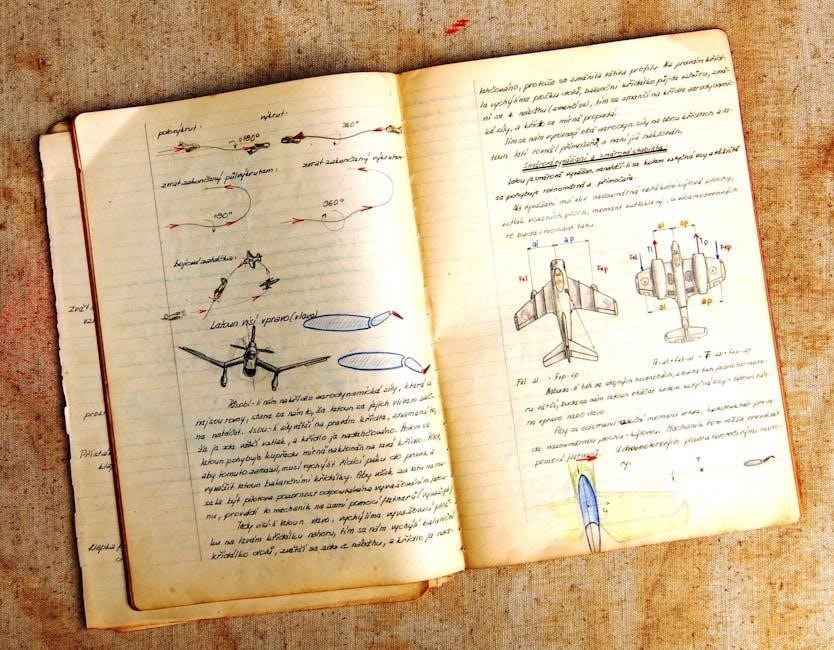Flight Paramedic Study Guide Overview
The Flight Paramedic Study Guide provides comprehensive resources for exam preparation, including detailed reviews, practice questions, and expert strategies to master critical care concepts effectively.
The FP-C (Flight Paramedic Certification) Exam is administered by the International Board of Specialty Certification (IBSC) to evaluate a candidate’s knowledge, skills, and abilities in flight paramedicine. This challenging exam consists of 135 multiple-choice questions covering ten critical domains of paramedic practice. It is designed to ensure competency in high-acuity, dynamic environments. Passing the FP-C Exam demonstrates expertise in patient care during air transport, making it a cornerstone for advancing in this specialized field. Thorough preparation is essential for success.
Recommended Resources
Key resources for FP-C exam preparation include the Mometrix Flight Paramedic Study Guide, Kyle Faudree’s Comprehensive Study Guide, and the EPICC Review Course. These materials offer in-depth reviews, practice questions, and expert strategies. Additionally, flashcards by Ty Hobbs and online platforms provide adaptive learning tools. Utilizing these resources ensures a well-rounded understanding of critical care concepts, flight physiology, and patient assessment techniques, helping candidates achieve exam success and mastery of flight paramedicine.
Mometrix Flight Paramedic Study Guide
The Mometrix Flight Paramedic Study Guide is a highly regarded resource for FP-C exam preparation. It provides a thorough review of critical care concepts, including trauma assessment, respiratory management, and cardiovascular emergencies. The guide includes hundreds of practice questions and flashcards to reinforce learning. Additionally, it offers expert test-taking strategies to help candidates navigate the exam confidently. This comprehensive tool is designed to ensure mastery of the essential skills and knowledge required for flight paramedicine.
Kyle Faudree’s Comprehensive Study Guide
Kyle Faudree’s Comprehensive Study Guide is an invaluable resource for FP-C exam preparation, offering detailed insights into critical care topics such as flight physiology, trauma management, and advanced airway techniques. The guide includes practice questions, flashcards, and real-world case examples to enhance learning. Faudree’s expertise shines through with clear explanations and practical tips, ensuring candidates grasp complex concepts and apply them effectively during the exam and in real-life scenarios.
Exam Format and Structure
The FP-C exam consists of 135 multiple-choice questions, covering ten critical topics. Managed by the IBSC, it evaluates knowledge, skills, and competencies in flight paramedicine, ensuring thorough preparation is essential.
Question Types and Format
The FP-C exam features 135 multiple-choice questions, covering topics like trauma assessment, airway management, and pharmacology. Question types include scenario-based, prioritization, and critical thinking challenges. Designed to test both knowledge and practical application, the exam mirrors real-life flight paramedicine scenarios, ensuring candidates demonstrate expertise in patient care under pressure. The format emphasizes problem-solving and decision-making skills, reflecting the high-stakes environment of flight paramedicine.
Time Management and Scoring
The FP-C exam consists of 135 questions to be completed within 2.5 hours, emphasizing efficient time management. Each question is worth one point, with no penalties for incorrect answers. The passing score is approximately 70%, requiring careful allocation of time per question. Candidates should aim to spend about 1.5 minutes per question to ensure thorough consideration. Effective time management strategies, such as skipping complex questions and revisiting them later, are crucial for achieving a high score and successfully passing the exam.
Eligibility Requirements
Candidates must hold current paramedic certification, meet experience requirements, and complete specialized training. The IBSC administers the exam, with a passing score of approximately 70% required.
Certification Prerequisites
To qualify for the FP-C exam, candidates must hold a valid paramedic certification and meet specific experience requirements. The IBSC requires applicants to demonstrate competency in critical care and flight medicine. A minimum of 2-3 years of paramedic experience is typically recommended, with a strong emphasis on patient care in dynamic environments. Additional prerequisites include completing specialized training in flight physiology, advanced airway management, and trauma care. A background check and current CPR certification are also mandatory.
Experience and Qualifications
Flight paramedic candidates typically need 2-5 years of paramedic experience, with a focus on critical care and emergency settings. Proficiency in advanced life support skills, such as airway management and cardiac care, is essential. Many programs require experience in high-acuity environments, like trauma centers or emergency departments. Additionally, candidates should possess strong critical thinking and decision-making abilities, as well as the capacity to work effectively in high-stress, dynamic situations. Continuous education and adaptability to evolving medical practices are also crucial for success in this role.
Flight Physiology
Flight physiology explores how altitude and pressure changes affect the human body, focusing on oxygen therapy, gas laws, and their implications for patient care in aerial environments.
Altitude Effects and Oxygen Therapy
Understanding altitude effects is crucial for flight paramedics, as higher elevations reduce atmospheric pressure and oxygen levels, potentially causing hypoxia. Oxygen therapy is essential to maintain patient oxygenation, with paramedics needing to assess and manage hypoxia effectively. This includes monitoring oxygen saturation, adjusting flow rates, and recognizing signs of hypoxia, such as confusion or chest pain. Proper oxygen therapy ensures patient safety and comfort during flight, addressing the physiological challenges of high-altitude environments.
Gas Laws and Pressure Changes
Gas laws are fundamental to understanding the effects of altitude on the human body and medical equipment. Boyle’s Law explains how pressure and volume inversely relate, affecting gases in the body. Charles’s Law highlights temperature’s impact on gas volume. At high altitudes, lower pressure causes gas expansion, risking conditions like pneumothorax. Paramedics must manage oxygen systems and medical gases carefully, ensuring equipment functions correctly under varying pressures. Understanding these principles is critical for safe patient care during flight operations.

Flight Patient Assessment
Flight patient assessment involves a systematic approach to evaluating trauma or medical conditions, focusing on vital signs, injury patterns, and environmental influences on patient status.
Initial Trauma Assessment
Initial trauma assessment in flight paramedicine focuses on evaluating the patient’s airway, breathing, and circulation (ABCs), followed by a thorough physical exam and history. Environmental factors, such as altitude and noise, can complicate assessment accuracy. The Mometrix study guide emphasizes the importance of systematic evaluation to identify life-threatening injuries promptly, ensuring timely interventions and improved patient outcomes during transport.
Medical Patient Evaluation
Medical patient evaluation in flight paramedicine involves assessing non-trauma patients with diverse conditions, such as chest pain, respiratory distress, or neurological deficits. Paramedics must obtain a detailed history, assess vital signs, and perform a focused physical exam. The Mometrix guide highlights the importance of identifying underlying causes and monitoring for deterioration. Flight environments require adaptability, as altitude and noise can impact assessment accuracy. Continuous monitoring and timely interventions are critical to ensure patient stability during transport.

Airway Management
Airway management is crucial in flight paramedicine, involving advanced devices like laryngeal masks and endotracheal tubes. Paramedics must master techniques to secure airways effectively.
Advanced Airway Devices
Advanced airway devices like laryngeal mask airways (LMAs) and video laryngoscopes are essential for securing difficult airways in flight. These tools enable paramedics to manage patients with compromised airways effectively, ensuring adequate ventilation. Proper training and practice with these devices are critical to avoid complications. Resources such as Kyle Faudree’s guide and the Walls Manual provide detailed instruction on their use, emphasizing the importance of mastering these techniques for optimal patient care in critical situations.
Complications and Solutions
Common airway management complications include obstruction, device malfunction, and patient discomfort. Solutions involve proper sizing of devices, regular monitoring, and troubleshooting techniques. Kyle Faudree’s guide emphasizes minimizing risks through meticulous technique and preparedness. Resources like the Walls Manual provide strategies for overcoming challenges, ensuring patient safety and effective care during flight operations. Continuous training and experience are key to mastering these critical skills for optimal outcomes in high-stakes environments.

Ventilation and Respiratory Management
Mastering ventilation and respiratory care is crucial for flight paramedics, involving advanced techniques, device management, and understanding acid-base balance to ensure optimal patient oxygenation and comfort during transport.
Flight Ventilators and Techniques
Flight ventilators are critical tools for managing respiratory care in aeromedical settings. Portable devices like the Dräger Oxylog 3000 are designed for durability and ease of use in flight. Paramedics must master techniques such as positive end-expiratory pressure (PEEP), pressure support ventilation, and volume control to ensure optimal oxygenation. These methods help maintain patient stability during transport, addressing conditions like hypoxia or respiratory failure. Proficiency in ventilator operation and adaptive strategies is essential for delivering high-quality care in dynamic flight environments.
Acid-Base Balance and Management
Acid-base balance is crucial in critical care, especially during flight. Paramedics must assess pH levels, bicarbonate, and carbon dioxide to identify acidosis or alkalosis. Common conditions include respiratory acidosis from hypoventilation or metabolic acidosis due to tissue hypoperfusion. Management involves correcting underlying causes, such as adjusting ventilation or administering buffers. In-flight lab diagnostics and clinical assessment tools help guide interventions. Maintaining proper acid-base balance ensures organ function and patient stability, requiring precise monitoring and timely adjustments in the aeromedical environment.

Cardiovascular Management
Cardiovascular management focuses on ECG interpretation, identifying dysrhythmias, and administering cardiac medications. Paramedics must stabilize patients with interventions like pacing and vasopressors to maintain cardiac function during flight.
ECG Interpretation in Flight
ECG interpretation in flight is critical for identifying cardiac dysrhythmias and guiding interventions. Paramedics must accurately analyze waveforms to detect conditions like atrial fibrillation or ventricular tachycardia; Challenges include motion artifacts and noise, requiring precise electrode placement and skill. Key strategies involve recognizing P, Q, R, S, and T wave abnormalities, measuring intervals, and correlating findings with patient symptoms. Proficiency in 12-lead ECG analysis is essential for diagnosing myocardial infarctions or ischemia. Regular practice and review of sample tracings improve accuracy in high-stakes environments, ensuring timely and appropriate care during transport.
Cardiac Medications and Interventions
Cardiac medications and interventions are vital in flight paramedicine for managing acute cardiac conditions. Key medications include Amiodarone for arrhythmias, Lidocaine for ventricular fibrillation, Nitroglycerin for chest pain, and heparin for thrombosis prevention. Paramedics must administer these via IV or intraosseous routes, adjusting dosages based on patient weight and condition. Monitoring for adverse effects, such as hypotension or bleeding, is crucial. Understanding pharmacodynamics and drug interactions ensures safe and effective treatment. Proficiency in these interventions is essential for optimizing patient outcomes during transport.

Trauma and Burn Management
Trauma and burn management in flight paramedicine focuses on rapid assessment, stabilization, and wound care to prevent complications. Techniques include hemostatic dressings, tourniquet use, and fluid resuscitation to maintain perfusion.
In-Flight Trauma Care
In-flight trauma care requires rapid assessment and stabilization of critically injured patients. Paramedics must manage hemorrhage with tourniquets and hemostatic dressings, while addressing shock through fluid resuscitation. Splinting fractures, controlling bleeding, and preventing hypothermia are critical interventions. Pain management and reassessment ensure patient stability during transport. Advanced techniques, such as needle decompression for tension pneumothorax, may be employed. Effective communication with the flight crew and ground teams ensures seamless care continuation. This section emphasizes practical strategies for managing trauma in austere environments, supported by evidence-based protocols and expert recommendations from resources like Kyle Faudree’s guide.
Burn Management Techniques
Burn management in flight requires prompt assessment and intervention to minimize tissue damage and prevent infection. Paramedics should cool burns with sterile saline, avoid direct ice contact, and apply topical antibiotics. Assessing burn depth and percentage using the Rule of Nines guides fluid resuscitation and pain management. Securing sterile dressings prevents contamination, while monitoring for inhalation injuries is crucial. Hypothermia prevention and wound care are emphasized to promote healing and reduce complications. These techniques ensure optimal prehospital burn care during transport.

Neurological and Pediatric Care
Flight paramedics must master neurological assessments, including Glasgow Coma Scale and pupil reactivity, and pediatric care, focusing on age-specific interventions, weight-based medications, and respiratory support.
Neurological Patient Assessment
Neurological patient assessment involves evaluating the Glasgow Coma Scale, pupil reactivity, and motor responses to determine the level of consciousness. Flight paramedics must identify signs of neurological deterioration, such as altered mental status or lateralizing signs, and manage accordingly. Pediatric considerations include assessing for age-specific neurological milestones and developmental delays. Proper documentation and timely intervention are critical to prevent further complications during transport. This section emphasizes the importance of accurate neurological evaluation in ensuring optimal patient outcomes.
Pediatric Considerations in Flight
Pediatric patients in flight require specialized care due to their unique physiological and anatomical characteristics. Assessment challenges include difficulty in communicating with young children and interpreting their symptoms. Equipment must be appropriately sized for pediatric patients, and medication dosages must be carefully calculated based on weight. Environmental factors, such as altitude changes, can exacerbate respiratory issues in children. Effective communication with parents or guardians is crucial for obtaining medical history and providing reassurance. Flight paramedics must be prepared to manage pediatric emergencies with precision and compassion to ensure optimal outcomes during transport.
Infection Control and Crew Management
Infection control is critical in flight settings to prevent disease transmission. Crew members must maintain sterility, use PPE, and ensure proper hand hygiene. Effective communication and teamwork are essential to manage infections and maintain a safe environment for patients and crew alike.
Sterility and Infection Prevention
Sterility and infection prevention are paramount in flight paramedicine to minimize disease transmission. Paramedics must adhere to strict protocols, including the use of PPE, proper hand hygiene, and disinfection of equipment. Understanding the Chain of Infection is crucial to breaking it and preventing contamination. Maintaining a sterile environment during procedures ensures patient safety and reduces the risk of nosocomial infections. These practices are vital in the confined and high-stakes setting of air medical transport, where infection control can significantly impact patient outcomes and crew health.
Effective Crew Communication
Effective crew communication is vital for seamless operations during medical flights. Clear, concise messaging and active listening are essential to prevent errors. Utilizing standardized terminology ensures clarity, while non-verbal cues like hand signals enhance coordination. Regular briefings and debriefings foster a collaborative environment, minimizing misunderstandings. Effective communication strengthens teamwork, improves decision-making, and ultimately enhances patient care. It is a cornerstone of successful flight paramedic operations.

Pharmacology and Lab Diagnostics
Covers essential medications, their effects, and administration guidelines for in-flight patient care. Includes lab interpretation techniques to aid diagnosis and treatment decisions during medical emergencies.
Common Flight Medications
Flight paramedics must be proficient in administering medications like fentanyl, midazolam, and dopamine for pain, sedation, and cardiac support. Demerol is often used for pain due to its effectiveness, while morphine is avoided in certain cases to prevent sphincter of Oddi spasms. Understanding dosages, contraindications, and administration routes is critical. These medications are vital for stabilizing patients during transport and addressing emergencies like seizures or hypertension. Proper knowledge ensures safe and effective patient care in the air.
Lab Interpretation in the Air
Lab interpretation is crucial for flight paramedics to diagnose and manage patients. Key labs include complete blood counts (CBC), basic metabolic panels (BMP), and troponin levels for cardiac issues. Elevated lipase and amylase levels may indicate pancreatitis, while abnormal coagulation studies suggest bleeding disorders. Understanding these results helps guide in-flight treatment decisions, such as fluid resuscitation or pain management. Accurate interpretation requires combining lab data with clinical assessment to ensure appropriate care during transport.
Test-Taking Strategies
Effective test-taking strategies include time management, question analysis, and elimination of distractors. Stay calm, focus on high-probability answers, and review questions to optimize performance and reduce errors.
Approaching Multiple-Choice Questions
When tackling multiple-choice questions, carefully read each question and all answer options. Eliminate obviously incorrect choices first to narrow down possibilities. Focus on key terms and concepts from your study materials, such as those outlined in Mometrix or Kyle Faudree’s guides. Use the process of elimination and make educated guesses when unsure. Manage your time wisely, allocating about one minute per question. Stay calm and systematic, ensuring you answer every question to maximize your score. Practice with sample questions to refine your strategy and build confidence.
Exam Day Preparation and Mindset
On exam day, arrive early and fully prepared with all necessary materials, including valid ID and any required documents. Stay calm and focused, avoiding last-minute cramming. Ensure you’re well-rested and hydrated to maintain mental clarity; Review your study guide briefly, such as Mometrix or Kyle Faudree’s resources, to reinforce key concepts; Approach each question methodically, taking deep breaths to manage stress. Trust your preparation and stay confident, knowing you’ve put in the effort to succeed. A positive mindset is crucial for optimal performance.
